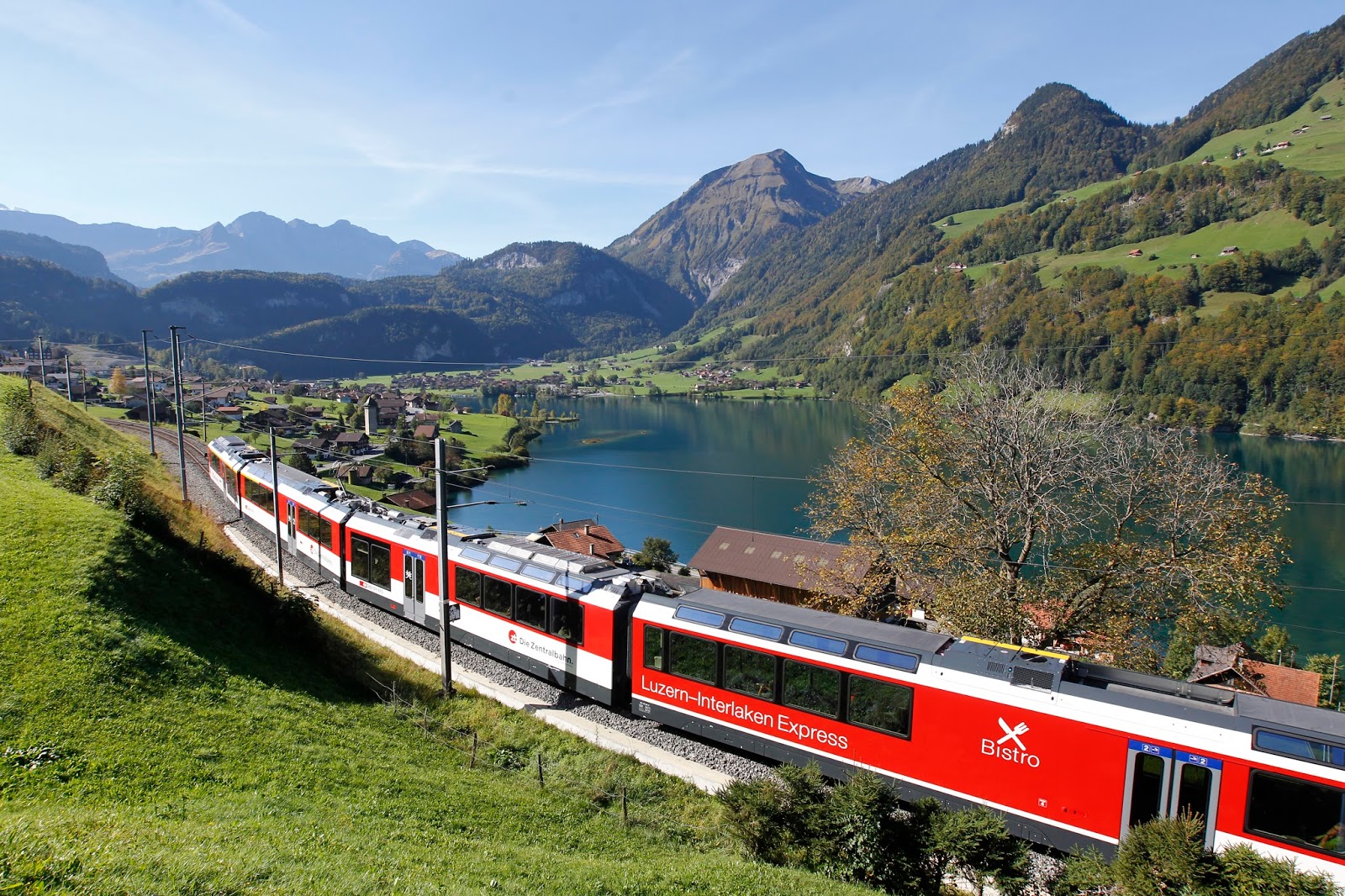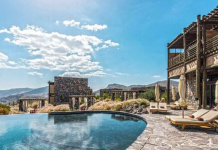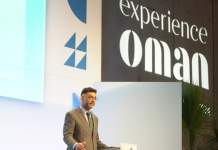Alpine valleys will seduce your senses, leaving you with no option but to simply surrender to the temptation of majestic mountains, crystal-blue lakes, verdant valleys speckled with quaint chalets and, above all, the eternal snow. Muhameed Nafie reports
As our cable car glided its way through the breathtaking views of the Swiss Alps above Davos, Europe’s highest city at an altitude of 1,560 metres, I suddenly realised that my visit to the much-vaunted location of World Economic Forum (WEF) has somehow turned out to be a literary pilgrimage. When our guide was waxing eloquent about the history of our destination, a sanatorium-turned mountain resort located 300-metre above the city, I found myself summoning up memories of a novel I devoured during my formative years in college.
It was the second day of our ‘Grand Train Tour of Switzerland’, organised by Switzerland Tourism, and we, a handful of journos from Dubai and Muscat, were heading to visit the setting of Thomas Mann’s metaphysical novel ‘The Magic Mountain’, one of the monumental works of the 20th century German literature. While hovering in the air, en route to the erstwhile sanatorium, I tried to evoke the novel’s plot and characters that I first came across years ago from a dog-eared paperback edition, that I borrowed form a library and read, during a vacation, sitting in the dim light of a kerosene-lamp in our village cottage thatched by coconut fronds. I tried to visualise Hans Castorp, the protagonist, taking the narrow-gauge railway up through the Alps in 1910s on his way to the sanatorium, which was built on a high plateau to provide rest cures for tuberculosis patients.
Aurelia Schmid, our guide in Davos, looked so passionate about the novel that she recollected each character and depicted how they lived in the sanatorium. She said Thomas Mann had gained extensive first-hand information on life in the sanatorium from his own stay in Davos with his wife Katia who had undergone treatment for tuberculosis over there.

Despite the cable cars taking ‘pilgrims’ to and fro, an extensively refurbished sanatorium and a couple of utility buildings around, the entire magic mountain seemed to be stuck in a time warp. The monument has now been converted to a hotel called The Schatzalp, without changing its architecture, and is surrounded by a botanic garden – the Alpinum Schatzalp – with 3,000 species of alpine plants. With the discovery of penicillin in 1940s, Davos had lost much of its sheen as Europe’s sole tuberculosis treatment destination, but the fresh and pristine air you breathe in can still vouch for the plateau’s exceptional therapeutic properties.
Nestling in a unique mountain scenery, downtown Davos was a far cry from my expectation of a modern sprawling city which hosts a forum of WEF’s stature, touted as the annual retreat of the world’s influential leaders and wealthiest people. When we went for a leisurely stroll in the evening along the promenade across the Congress Centre, that hosts the meetings of WEF since 1971, it wore an almost deserted look, except for a few teenagers who hanged around in a nearby garden. We were told that Davos remains overly quiet and laidback in the off season, between WEF and the beginning of winter; but the town will be crowded by skiing and snowboarding fans during the winter, when it also hosts an annual ice hockey tournament. According to general manager of Hotel Grischa, a four-star facility in Davos Platz, where we stayed, although the city is bracing itself to meet the surging demand during the WEF season by opening new four-star and five-star hotels, occupancy rates of almost all hotels remain very low during the off-season months.
Integrated public transport
Actually, the Davos leg of our trip was preceded by a few hours in Zurich, where we were flown in from Muscat and Dubai, enjoying an eight-hour luxurious and uber-cool business class journey on board Swiss International Air Lines, which literally pampered the gourmet in us and offered a good night’s sleep. The Swiss business longue at Zurich airport also treated us to the highest comfort where we could freshen up with a shower and enjoy an extensive breakfast buffet before setting off the tour.

Before embarking on our journey, we were handed over what was going to be a ‘travel talisman’ during our stay in Switzerland- the Swiss Travel Pass which entitles you to unlimited travel across the length and breadth of Switzerland by train, bus and boat of Swiss Travel System network. It covers scenic routes as well as local trams and buses in 75 towns and cities, and offers 50 per cent reduction on most mountain railways and cable cars. The Swiss Travel Pass also includes the Swiss Museum Pass, allowing you free entrance to 480 museums and exhibitions.
The Grand Train Tour of Switzerland, launched by Swiss Travel System in 2015, is adding excellence to arguably one of the most efficient and sophisticated public transport system in the world that Switzerland boasts of. Hailing from a country where delayed train is a norm rather than an exception, I was so impressed by the punctuality of the Swiss trains; so much so that they were named after the exact minute they were expected at each railway station; and you need not look for name boards on each railway station to check whether it is where you have to get down, but just feel relaxed once you knew the time the train is expected at your destination, and you can get down wherever the train stops at that exact minute!
A few second’s delay in arriving at Zurich main railway station, which can never be called ‘late’ by our Indian or Middle East standard, caused us to lose our scheduled train to Klosters and made us wait for almost one hour before catching the next one. Luckily, thanks to the effective luggage handling services of Swiss Federal Railways, we had got rid of our heavy luggage at a counter in Zurich railway station to be collected later in the evening at our hotel in Davos, where we would reach after a daylong travel and sightseeing.

After getting down in Klosters, a quaint and picturesque town, we were taken to Museum Nutli Hüschi, a local museum originally built in 1565, which featured traditional life of the Walser from 17th to 19th century. The unusually small beds in the house were designed to make people sleep sitting bolt upright, because they feared that only the dead people could sleep lying flat. After a traditional mid-morning snack in the scenic courtyard of the museum, we set off for Davos Sertig, a stunning glacial valley, in the foot of three snow-capped mountains, speckled with wooden cottages and decked with waterfalls formed by melted snow from the mountains.
The eternal snow
The most riveting part of the trip came the next day when we started on a seven-hour journey in the Glacier Express from Davos to Zermatt via Filisur. The Glacier Express takes you on a day trip from St. Moritz to Zermatt through unspoiled mountain terrains covered with glistening snow, deep gorges guarded by snow-capped peaks, dazzling valleys interspersed with wooden cottages and dotted with grazing cows. We were told that the train traversed through a total of 91 tunnels and 291 impressive bridges.

This unforgettable and captivating train journey culminates in the pedestrians’ city of Zermatt, where you cannot see cars except for a few electric vehicles that shuttle people from the train station to hotels. We stayed at Hotel Alex, one of the best in the city. The city is famous for Matterhorn glacier paradise, Europe’s highest aerial cableway and summit station.
The next morning we walked across to the Valley Station and took the gondolas (which almost resembled a cable car) up to the peak of Matterhorn glacier paradise. It offered us a breath-taking view of Italian, French and Swiss alpine giants from an altitude of 3,883 metres from where Mont Blanc, the highest mountain in the Alps, seems near enough to touch.
Then we went 15 metres below to visit the world’s highest glacier palace, a fairytale place built in the heart of eternal ice, where you will be greeted with glittering ice crystals and shimmering ice sculptures, in addition to ice bench covered with cosy furs. We came out chilled to the bone, our hands numbed with cold, but that was something a few of us will treasure the memory of, for the rest of our life.
After a sumptuous meal at the Restaurant Matterhorn Glacier Paradise, we took gondolas to come back to the village. The rest of the day we were left to our own devices before meeting for dinner at a restaurant. Many of us took this opportunity to visit Matterhorn Museum – Zermatlantis, which took us for a ride down Zermatt’s memory lane, including the tragic tale of four mountaineers’ death during the first ascent of Matterhorn. Later, two of us opted to while away the time taking an easy saunter across the lovely streets of Zermatt. After two nights at Zermatt, the next morning we took a train to Montreux, the French-speaking part of Switzerland, on the shore of Lake Geneva.
Nestling between lake and mountains, Montreux is the town of music and is famous for its Jazz Festival. On the market square we had seen a bronze statue of Freddie Mercury overlooking the lake. He had immortalised the Lake Geneva and peaks of the Grammont on the cover of his album “Made in Haven”. We took a train to visit the neighbouring district of Vevey to attend a short watchmaking workshop where a father-son duo showed us how a watch is made with all the little details and answered our queries.
Then we proceeded towards Chillon Castle on a boat. Located on a rocky island, the Chillon Castle is the most visited monument in Switzerland. Numerous artists and writers were inspired by the medieval fortress, such as Jean-Jacques Rousseau, Victor Hugo, Delacroix, Courbet and Lord Byron, who wrote the famous poem “The Prisoner of Chillon” (1816). Two magnificent halls were available for banquets, and the castle is a particularly popular venue for medieval evenings; preparations for such an event were going on in the entrance while we came out of the castle.
After having dinner at Le Palais Oriental, a grand Moorish-style building located in a naturally majestic setting on the shores of Lake Geneva, we took a walk back to our hotel Eurotel Montreux, along the lake boulevard enjoying the beautiful sunset down an overcast sky. When it rained later in the night, we had a stunning view of the city sitting in the balcony of our respective rooms that overlooked Lake Geneva.
The golden route
The next morning, we set off on the last leg of our Swiss tour, taking the Golden Pass panoramic train to Lucerne. One of the most treasured routes in Switzerland’s rail network, the Golden Pass line stretches nearly 150 miles from Lake Geneva to Lucerne. Sitting on the vantage point of our VIP seats, we had the unforgettable glimpses of so many of Switzerland’s highlights from Montreux to Zweisimmen where the train moved past quaint chalets, nuzzled in the valleys with the jagged, snow-topped peaks as a backdrop. From Zweisimmen to Interlaken we took another train along Lake Thun and a third train from Interlaken to Lucern moving past several lakes and pastures, through the Brünig Pass, around the Giessbach waterfalls. We idly sat, simply surrendering to the temptation of greener pastures, bluer lakes and whiter peaks!

One of the most happening tourist places in central Switzerland, Lucerne holds in store for you a wide range of attractions in terms of its centuries-old sights such as the Chapel Bridge, the Musegg Wall, the Lion Monument and the historic Old City. But, we had only a couple of hours in hand to have a quick walking tour of the city. The key attraction of our guided city tour was Chapel Bridge that spanned diagonally across the Reuss River. The oldest covered wooden footbridge in Europe, Chapel Bridge contained a number of interior paintings dating back to the 17th century. Although most of the bridge and many of its paintings were destroyed in a fire in early 1990s, they were restored subsequently.

The tour of Lucerne, the final destination of our six-day long ‘Grand Train Tour of Switzerland’ culminated with a typical Swiss dinner at Stadtkeller restaurant at downtown Lucerne, accompanied by an enthralling performance of Swiss folklore and folk-music such as yodeling, alphorn blowing and flag throwing which we enjoyed (and some of us performed too) up to the hilt.
While we were having what a team member sarcastically described as ‘our last supper in Switzerland’, it began to cloud over outside followed by heavy pouring for a while. By the time we were through with dinner and our share of folklore and folk music, the rain had subsided. We took a swift stroll along the lake promenade to Palace Luzern, a five-star facility overlooking Lake Lucerne, where we spent the last night of the trip.






